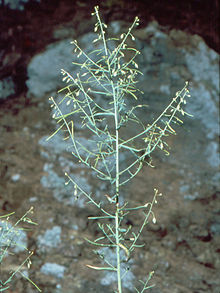Borodinia serotina
| Borodinia serotina | |
|---|---|

| |
| Scientific classification | |
| Kingdom: | Plantae |
| Clade: | Tracheophytes |
| Clade: | Angiosperms |
| Clade: | Eudicots |
| Clade: | Rosids |
| Order: | Brassicales |
| Family: | Brassicaceae |
| Genus: | Borodinia |
| Species: | B. serotina
|
| Binomial name | |
| Borodinia serotina (E.S.Steele) P.J.Alexander & Windham
| |
| Synonyms | |
| |
Borodinia serotina is a rare species of flowering plant in the
Description
This is a biennial herb which has a small, inconspicuous basal rosette of leaves measuring a few centimeters wide. It bolts with an erect, branching stem that can reach a maximum height near one meter. Leaves along the stem may be 5 to 15 centimeters long, lance-shaped, and sometimes toothed along the edges. Leaves wither early, and the plant may have few or no leaves at flowering. The inflorescence is a raceme of several tiny white flowers each under a centimeter wide. The fruit is a silique measuring 4 to 8 centimeters in length and containing many small seeds.
Habitat
This endangered plant grows in mid-Appalachian shale barrens, an eroding shale scree of Devonian origin.[5] This habitat occurs in Virginia pine woodlands and is made up of unstable rock and thin soils which are largely weathered fragments of shale known as channery.[5] Most populations of the plant have a few individuals.[1] The rocky soils receive direct sunlight that makes them too hot (up to 63 °C) to support many plant species.[1]
Endangered status
The plant was listed as a federally endangered species in 1989.[3] In Virginia, it was given an S1 ranking ("Critically Imperiled") in 1991,[citation needed] and it is currently listed as S2, "imperiled", in both Virginia and West Virginia by NatureServe.[1]
The plant is
References
- ^ a b c d e f g h i j NatureServe (1 March 2024). "Borodinia serotina". NatureServe Network Biodiversity Location Data accessed through NatureServe Explorer. Arlington, Virginia: NatureServe. Retrieved 21 March 2024.
- ^ a b "Shale barren rock cress (Boechera serotina)". Environmental Conservation Online System. U.S. Fish & Wildlife Service. Retrieved 21 March 2024.
- ^ a b c Morgan, Sharon W.; Bartgis, Rodney L.; U.S. Fish and Wildlife Service (1989). "Endangered and Threatened Wildlife and Plants; "Arabis Serotina" (Shale Barren Rock Cress) Determined to be an Endangered Species". Federal Register. 54 (133): 29655–29658. 54 FR 29655
- ^ a b Center for Plant Conservation Archived December 15, 2010, at the Wayback Machine
- ^ a b c d Nott, M. P. (2006). Shale barren rock cress (Arabis serotina): A literature review and analysis of vegetation data. A report to the Navy Information and Operations Command. Archived July 25, 2011, at the Wayback Machine


